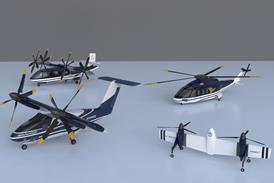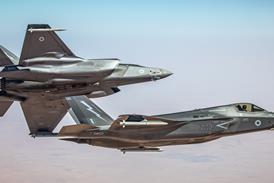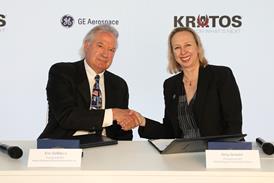David Learmount/LONDON
Facing change and living with cuts is not new to air forces around the world. But new practices, changes in priorities and having to economise on everything from training and flying hours to aircraft parts is a flight safety problem which will cost the loss of aircraft and possibly lives. The challenge is to minimise the numbers.
Recent history suggests that the air arms of the world's more powerful nations will be deployed in progressively more conflicts, but frequently not in defence of their own country. Today, leaving aside civil war or cross-border disputes, the deployment of sophisticated military force is more likely to be to far-flung places in defence of the wider interests of the state and its economy - or of the interests of an alliance - or to take part in operations which are intended to contribute to global or regional stability. This situation faces particularly those military air arms in countries which maintain an active commitment to NATO or to UN forces.
Designed to be highly portable and rapidly deployable, today's military aviation forces must operate in unfamiliar and often remote and austere surroundings with limited access to supplies and equipment - sometimes under unclear chains of command. Even at home base, ageing aircraft, maintenance problems and the lack of spare parts have been facts of life for militaries in the post-Cold War era in which today's stability can quickly shift into tomorrow's upheaval.
And all must be accomplished with ever-tightening defence budgets.
No link has been proved between the military's changing role and day-to-day flight safety, and surprisingly, no such study is under way. But the secondary effects of the consequent task overloading combined with underfunding are of concern to some senior military leaders.
Stretching thinly
A report by the US Navy Office of Information describes a worrying picture: "Naval aviation is being stretched thin. Maintenance and supply personnel have been (and are being) overworked to compensate for shortfalls in resources; this has become accepted practice to meet commitments." The cost of doing business, as one squadron commanding officer put it, is not "working our people until they drop from exhaustion", but rather "working them until they leave in frustration". Another squadron skipper observed, "The problem is we have a 15-carrier requirement, a 12-carrier navy, and a 10-carrier budget."
Spares cannibalisation from ground-based aircraft supposed to be working up for their next carrier deployment is rife, and despite a financial year 1999/2000 budget injection of $227 million targeted at the spares deficit, the total allocated still does not reach the requirement.
In the first half of 1999, Royal Navy Capt Simon Locke, then chief staff officer to the Flag Officer Naval Aviation, wrote in the RN's flight safety magazine Cockpit: "Over recent months there has been a disturbing increase in avoidable accidents which cannot be attributed to any hard and fast cause. Suggestions have been made that it could be due to additional pressures caused by high levels of 'robbery' [taking spares from other aircraft]...or stretch caused by gapping and dilution of experience levels, or, more generally, 'stretch fatigue'." Gapping means operating without a full complement of personnel.
The RN reports a doubling in the rate of "avoidable occurrences" in the last two years, the only comfort being that the rate of increase has slowed, and actual accidents remain few. There is, however, no provable link with specific pressures. In his comments about "stretch fatigue" and its factors, Locke said: "Whilst the statistics don't really support these ('stretch fatigue') views, a degree of frustration at these issues is well understood." He appealed to anyone who had "real examples" of stress-related errors, or situations which cause them, to report them. Some six months later Commodore Simon Thornewill, also writing in Cockpit, expanded on the same theme: "Financial stringency is here to stay and we need to recognise that reduced (training) flying hours, paucity of spares, gapping and dilution of experience will continue to put pressure on our operations."
The USN also says that there is no way of proving a connection between these modern stresses and flight safety, but the Information Office report observes: "Some commanders were worried about the damage that has been done to the young sailor and marine who now sees cannibalisation as an accepted maintenance practice. Other commanders talked about having to be more vigilant over our young people, fearing they could bypass safety practices under pressure to repair an aircraft for a mission. Although safety per se has not been compromised, there are indications that safety is on the ragged edge."
Research among both naval and US Marine Corps aviation personnel indicated that the pressures on engineers and aircrew led to a belief that the leadership did not know or care what was going on in the hangars and in the cockpit. As a result more than 70% of those surveyed were inclined to leave the service.
Royal Australian Air Force Deputy Director Flying Safety Wg Cdr Ian Warburton comments: "Rapid deployments do place extra stresses on the safety system, and we deal with that by using risk management procedures. It is certainly a training issue, and it's not just training in operating the aircraft...When units are not engaged in actual deployments, they're engaged in practice deployments all the time, including exercises overseas. So the difference between a practice deployment and a real one, such as East Timor, is not notable."
Fatigue on deployment has to be monitored carefully, Warburton says.
Combining resources
Deliberations about how to get the best performance out of shrinking military resources often result in moves to combine air force, navy, and army aviation into one air arm. This process is accelerating in the UK, while in the US military so-called 'purple' operations, meaning involvement of more than one service, have become a way of life. The RN remarks that as it is working ever more closely with other services, it needs to remember that Royal Air Force crews particularly are not used to the maritime environment.
In addition, joint military operations, whether multinational or national, have involved unclear and contradictory chains of command, muddying the waters further.
The US Air Force saw problems arise in the new rapid and frequent reaction environment - such as family stresses, low morale, decreased retention and lowered workforce experience, all of which can ultimately affect flight safety. It is a year into a system to stabilise its forces.
Chief of Staff Gen Michael Ryan explains: "We don't see safety issues associated with overseas deployments. A year ago, we instituted the Aerospace Expeditionary Forces (AEF) rotation schedule, putting a pilot into a 90-day vulnerability period. This gives them a predictable schedule. We were having trouble with the old system, with long deployments. This has helped a lot. It gives stability to the force."
The AEF units take turns handling short-notice overseas deployments. There are 10 permanent AEFs with two on alert at any given time for a 90-day period every 15 months. That allows a manageable rotation and spreads the workload across the 10 AEFs, which include active duty, Air National Guard and USAF Reserve units. Theoretically, active duty personnel and reservists know when they are liable to be called on for deployment. In the post-Cold War era, pilots complained about repeat deployments to austere airbases and monotonous duties like enforcing no-fly zones over Iraq. USAF leaders acknowledge that frequent deployments - along with operational pace and erosion of military pay and benefits - played a major role in the loss of pilots to airlines, affecting experience levels and increasing workloads for those who remained.
Stop-gap measures
At one time, the USAF projected a shortfall of 2,000 pilots by 2002, but increases in re-enlistment bonuses and higher bonuses for pilots have improved the situation.
These, however, are only stop-gap measures, says Ryan: "The situation is better than we thought it was going to be, quite honestly. We thought we'd have a shortage of 1,800 pilots, but that was projected before we got some help from the [Clinton] administration and the US Congress in terms of pilot bonuses which give our people some security and the ability to plan ahead in their lives. They had a lot of alternatives on the outside. Now we project to be only 1,200 pilots short and we see that decreasing over the next five years to about 700. We are working our way out of a pilot shortage.
"For the long-term we have instituted a 10-year active duty service commitment. That will help a lot, allowing for a more experienced force. It takes about four years to fully train a pilot; having them stay another six years yields 60% more company grade pilots. But this benefit won't kick in until the end of the decade."
That is not all, however, he says: "We must continue to work on the incentives to serve, such as mission satisfaction and sustainable operations tempo, reasonable stability, family security. We must also offer our service members competitive pay, comprehensive medical care, and a reasonable retirement."
Still subject to the pressures of rapid response and frequent deployments are the USAF's high demand, low density elements such as special operations, airborne warning and control systems and airborne intelligence, which do not fit neatly into AEFs. Sources say that while some such elements are experiencing an easing of their hardships, they continue to face comparatively high deployment rates and higher than average workloads.
Meanwhile politicians commit the armed services to perform to the highest standards regardless of decisions by the exchequer.
The USN report observes: "Problems include escalating maintenance costs associated with our ageing aircraft fleet and increased utilisation rates that are rapidly consuming airframe service life. The navy is wearing out its aviation fleet. Our airplane inventory is now older than it has been at any time in the history of naval aviation, yet through programmatic decisions and budget cuts we have decimated the very engineering and logistics support efforts that we now desperately need to sustain our ageing aircraft into an increasingly uncertain future." The navy predicts that its fleet average age of 14.5 years in 1999 will rise to 16.2 years in 2003.
Indian example
Elsewhere, in less prosperous countries with a smaller number of units among which to spread the load, the results of defence budget-related cuts are even more evident in personnel numbers and equipment.
Senior officers, duty bound to see that the job is done, apply all the traditional flight safety disciplines, feeling relatively powerless in the face of a problem which common sense suggests is there but the direct effect of which cannot be proven.
There are other ways of ignoring - at the political level - flight safety, and risking paying for it in terms of aircraft, lives and expertise lost. India provides the classic example.
This year its air arms suffered 30 serious accidents and losses - about three of the losses stemming from the Kashmir conflict with Pakistan. Leaving aside conflict casualties, however, India's air arms have for a decade suffered an appalling attrition rate, particularly in its high performance fighters.
The cause has been known for years, too. India has been putting into Mikoyan MiG-21 Fishbed fighters - which may not be modern but have Mach 2 performance - pilots who were not trained for high-performance fast-jets. Advanced training is still carried out on the low performance Hindustan Aeronautics Kiran or the PZL Iskra, and now India is losing RSKMiG-29s as well as MiG-21s.
In November 1998 the Indian Government's auditor general reported that the lack of a suitable advanced jet training aircraft was "the main reason for human error accidents" during the period 1991-97. Candidate trainers had then been on the cards for years. The main contenders were the Dassault Dornier Alpha Jet and the BAE Systems Hawk 100. In August this year, the government signalled that a deal to buy Hawks is expected to be signed "by the end of the year", with deliveries beginning in 2004.
Canada may become a component in an international plan for consolidating military basic and fast jet pilot training. It has a privatised training facility at the Canadian Forces base Moose Jaw, run by a Bombardier-headed consortium which supplies training to its own pilots. Denmark, Italy, Singapore and the UK are among third parties who have signed up for training there.
The question that must be answered is whether combining the training of many air forces will affect flight safety as well as training costs.
Source: Flight International























